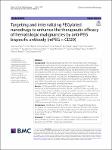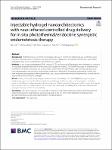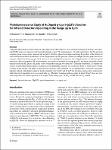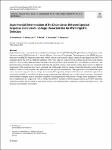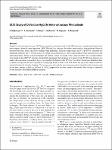Search
Author
- Osman, Ahmed I. (5)
- Daqing, Ma (3)
- Jorgensen, Ed (3)
- Li, Yan (3)
- next >
Subject
- kinh tế (26)
- Economics (12)
- programming (10)
- XRD (10)
- next >
Date issued
- 2020 - 2025 (2129)
- 2010 - 2019 (129)
- 2000 - 2009 (9)
- 1999 - 1999 (1)
Has File(s)
Search Results
Bee pollen extract (BPE)-based polymer nanoparticles (BPENP) were fabricated using bovine serum albumin (BSA) and targeted with folic acid and were further characterized. Mice groups are: Group 1 received saline, whereas Groups 2, 3, 4, 5, and 6 received a single dose of urethane, followed by weekly injections of butylated hydroxy-toluene (BHT). After the BHT injection, the mice in Groups 3, 4, 5, and 6 received BPE, Avastin, BPENP, and BPENP + Avastin, respectively. The number and size of tumors were decreased in Group 6 compared to those in the other groups. The ratios of early and late apoptotic cells in Groups 3, 4, 5, and 6 (42.8%, 41.4%, 26.2%, and 45.4%, respectively) were higher than that in the untreated group. The PCNA-labeling indexes (LI)% in tissues and lesions from Gro... |
High-temperature oxidation behavior of conventionally cast and additively manufactured (AM) Co-base alloy MAR-M-509 was compared in the present study. The specimens were exposed in air at 1000 °C and characterized by means of scanning electron microscopy equipped with energy/wavelength dispersive x-ray spectroscopy (EDX/WDX) and electron backscatter diffraction as well as transmission electron microscopy. Substantial differences in the oxidation processes of two alloy versions were observed. Faster oxidation of the cast alloy was mainly induced by (1) oxidation of coarse primary carbides, (2) internal oxidation and nitridation processes and (3) incorporation of other alloy constituents (e.g., Co, Ni, W) into the Cr-oxide scale. AM specimens, in contrast, formed a more homogeneous, t... |
PEGylated nanoparticles (PEG-NPs) are not effective for hematologic malignancies as they lack the enhanced permeability and retention effect (EPR effect). Tumor-targeted PEG-NPs can systemically track lymphoma and actively internalize into cancer cells to enhance therapeutic efficacy. We generated an anti-PEG bispecific antibody (BsAb; mPEG × CD20) which was able to simultaneously bind to methoxy PEG on liposomes and CD20 to form multivalent αCD20-armed liposomes. This αCD20-armed liposome was able to crosslink CD20 on lymphoma cells to enhance cellular internalization and the anti-cancer efficacy of the liposomes to lymphoma. We generated mPEG × CD20 and used this bispecific antibody to modify PEGylated liposomal doxorubicin (PLD) through a one-step formulation. |
Alzheimer’s disease is a neurodegenerative disorder, and Aβ aggregation is considered to be the central process implicated in its pathogenesis. Current treatments are faced by challenges such as serious side effects and reduced drug bioavailability. In this study, we developed a drug delivery system for intramuscular injection that uses cellular activity to achieve constant and long-term drug release. |
Endometriosis is a common gynecological disease in women of childbearing age. Commonly used treatment methods, such as endocrine and surgical therapies, display poor therapeutic effects with a high relapse probability. Thus, novel treatments for endometriosis are required. |
The significance of waterlogged archaeological wood (WAW) lies in its profound informational value, encompassing historical, cultural, artistic, and scientific aspects of human civilization, and therefore need to be properly studied and preserved. In this study, the utilization of near-infrared (NIR) spectroscopy is employed as a predictive tool for assessing the hardness value of WAW. Given the submerged burial conditions, waterlogged wooden heritage frequently undergo substantial degradation in their physical and mechanical properties. The mechanical properties of waterlogged wooden heritage are essential for evaluating their state of preservation and devising appropriate conservation and restoration strategies. However, conventional methods for testing mechanical properties are l... |
A HgCdTe photodiode grown by chemical vapor deposition (MOCVD) on a GaAs substrate operating in the long-wave infrared (LWIR) range was characterized using photoluminescence (PL) measurements. At high temperatures, the PL spectrum originates from a free-carrier emission and might be fitted by a theoretical expression being the product of the density of states and the Fermi–Dirac distribution. At low temperatures, the PL spectrum consists of multiple emission peaks that do not originate solely from the energy gap. Such spectra are not unambiguous to interpret due to the prominence of different optical transitions. Spectral response (SR) measurements were used to determine the energy gap (Eg) and extract the band-to-band transition from the PL spectra. PL peaks visible within the band... |
Experimental results are reported for a medium-wavelength infrared (MWIR) HgCdTe photodetector designed in a joint laboratory run by VIGO Photonics S.A. and the Military University of Technology. The parameters of the MWIR detectors fabricated with HgCdTe heterostructures were studied. Advances in the metal–organic chemical vapor deposition (MOCVD) technique enable the growth of HgCdTe epilayers with a wide range of composition and doping, used for uncooled infrared detectors. Device-quality HgCdTe heterostructures were deposited on 2-inch-diameter, low-cost (100) GaAs substrates. The heterostructures obtained were examined measuring the spectral response and current–voltage characteristics in different temperatures. |
Deep-level transient spectroscopy (DLTS) measurements were performed on HgCdTe heterostructure photodiode grown by metal-organic chemical vapor deposition (MOCVD) on GaAs substrate. In order to extract defects from individual layers of the heterostructure, three consecutive etchings were performed. In the first experiment, the N+/T/p/T/P+/n+ structure was chemically etched to the N+ bottom contact to obtain a mesa-type detector. Six localized defects were extracted across the entire photodiode. In the second experiment, the bottom contact was made to the p-type absorber. Two localized defects were found in the p/T/P+/n+ structure. |
This paper presents the performance of an interband cascade long-wavelength infrared detector designed for high operating temperatures supported by immersion lenses. The device is based on the “Ga-free” InAs/InAsSb type-II superlattice with highly doped p+/n+ superlattice tunneling junctions connecting adjacent stages. Detectivity of the multi-junction heterostructure detector exceeding 1010 cm Hz1/2/W was estimated at wavelength λ ~ 9 µm and T = 210 K and ~ 3 × 108 cm Hz1/2/W for T = 300 K, achieving a tenfold improvement in detectivity in comparison to a device without an immersion lens and 30-fold improvement in detectivity in comparison to the single-stage device. |



